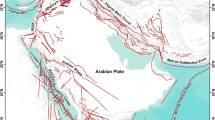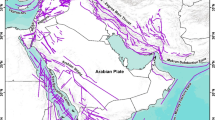Abstract
In recent years, the United Arab Emirates (UAE) has experienced an unprecedented growth which is coupled with the increase in seismic activity in the surroundings. Previous studies presents significant variations in their results whereas some recent studies although very detailed focus on only few cities. This study reviews the results of previous studies and presents new findings for the whole of UAE based on the improved source model and use of next generation attenuation (NGA) equations. The peak ground accelerations, spectral accelerations and deaggregation of hazard for major cities are presented. Moreover, the breakdown of the range of mapped spectral accelerations (S 0.2 and S 1) is proposed to form the basis for the development of site amplification factors in subsequent studies. The results of this study indicate almost similar values of ground motion compared to some recently published studies and smaller values compared to some earlier studies.














Similar content being viewed by others
References
Abdalla JA, Al Homoud AS (2004) Seismic hazard assessment of United Arab Emirates and its surroundings. J Earthq Eng 8(6):817–837
Abrahamson NA, Silva WJ (1997) Empirical response spectra attenuation relations for shallow crustal earthquakes. Seismol Res Lett 68(1):94–127
Abrahamson NA, Silva WJ (2008) Summary of the Abrahamson & Silva NGA ground motion relations. Earthq Spectra 24(1):67–97
Akkar S, Bommer JJ (2010) Empirical equations for the prediction of PGA, PGV and spectral accelerations in Europe, the Mediterranean Region and the Middle East. Seismol Res Lett 81:195–206
Aldama-Bustos G, Bommer JJ, Fenton CH, Stafford P (2009) Probabilistic seismic hazard analysis for rock sites in the cities of Abu Dhabi, Dubai and Ras Al Khaimah, United Arab Emirates. Georisk 3(1):1–29
Al-Haddad M, Siddiqi GH, Al-Zaid R, Arafah A, Necioglu A, Turkelli N (1994) A basis for evaluation of seismic hazard and design criteria for Saudi Arabia. Earthq Spectra 10(2):231–258
Ambraseys NN (1995) The prediction of earthquake peak ground acceleration in Europe. Earthquake Eng Struct Dynam 24(4):467–490
Ambraseys NN, Melville CP (1982) A history of Persian earthquakes. Cambridge University Press, London
Ambraseys NN, Simpson KA, Bommer JJ (1996) Prediction of horizontal response spectra in Europe. Earthq Eng Soil Dyn 25(4):371–400
Atkinson GM, Boore DM (1997) Some comparisons between recent ground motion relations. Seismol Res Lett 68(1):24–40
Atkinson GM, Boore DM (2003) Empirical ground-motion relations for subduction-zone earthquakes and their application to Cascadia and other regions. Bull Seismol Soc Am 93(4):1703–1729
Atkinson GM, Boore DM (2006) Earthquake ground-motions prediction equations for eastern North America. Bull Seismol Soc Am 96(6):2181–2205
Basham PW, Weichert DH, Anglin FM, Berry MJ (1985) New probabilistic strong seismic ground motion maps of Canada. Bull Seismol Soc Am 75(2):563–595
Bayer R, Chery J, Tatar M, Vernant Ph, Abbassi M, Masson F, Nilforoushan F, Doerflinger E, Regard V, Bellier O (2006) Active deformation in Zagros–Makran transition zone inferred from GPS measurements. Geophys J Int 165:373–381
Bazzuro P, Cornell CA (1999) Disaggregation of seismic hazard. Bull Seismol Soc Am 89(2):501–520
Berberian M (1995) Master ‘blind’ thrust faults hidden under the Zagros folds: active basement tectonics and surface morphotectonics. Tectonophysics 241(3–4):193–224
Boore DM, Atkinson GM (2008) Ground-motion prediction equations for the average horizontal component of PGA, PGV, and 5 %-damped PSA at spectral periods between 0.01 s and 10.0 s. Earthq Spectra 24(1):99–138
Brown GG (1972) Tectonic map of the Arabian Peninsula, Saudi Arabian directoriate general of mineral resources. Arabian Peninsula Map AP-2
Campbell KW, Bozorgnia Y (2008) NGA ground motion model for the geometric mean horizontal component of PGA, PGV, PGD, and 5 % damped linear elastic response spectra for periods ranging from 0.01 to 10 s. Earthq Spectra 24(1):139–171
Chiou B, Youngs R (2008) An NGA model for the average horizontal component of peak ground motion and response spectra. Earthq Spectra 24(1):173–215
Cornell CA (1968) Engineering seismic risk analysis. Bull Seismol Soc Am 58(5):1583–1606
Cotton F, Scherbaum F, Bommer JJ, Bungum H (2006) Criteria for selecting and adjusting ground-motion models for specific target applications: applications to Central Europe and rock sites. J Seismolog 10(2):137–156
Dahle A, Bungum H, Kvamme LB (1990) Attenuation models inferred from intraplate earthquake recordings. Earthquake Eng Struct Dynam 19(8):1125–1141
Ellison RA, Styles MT (2006) The geology and geophysics of the United Arab Emirates. Vol 1: executive summary. British Geological Survey, Keyworth, England, p 27
Engdahl ER, Jackson JA, Myers SC, Bergman EA, Priestley K (2006) Relocation and assessment of seismicity in the Iran region. Geophys J Int 167(2):761–778
Farhoudi G, Karig DE (1977) Makran of Iran and Pakistan as an active arc system. Geology 5(11):664–668
Fenton CH, Adams J, Halchuk S (2006) Seismic hazards assessment for radioactive waste disposal sites in regions of low seismic activity. Geotech Geol Eng 24(3):579–592
Ghobadi MH, Fereidooni D (2012) Seismic hazard assessment of the city of Hamedan and its vicinity, west of Iran. Nat Hazards. doi:10.1007/s11069-012-0203-8
Grunthel G, Bosse C, Sellami S, Mayer-Rosa D, Giardini D (1999) Compilation of the GSHAP regional seismic hazard map for Europe, Africa and the Middle East. Ann Geofis 42(6):1215–1223
Hanks TC, Kanamori H (1979) A moment magnitude scale. J Geophys Res 84:2348–2350
Harmsen S, Perkins D, Frankel A (1999) Disaggregation of probabilistic ground motions in the central and eastern United States. Bull Seismol Soc Am 89(1):1–13
Jackson JA, Fitch T (1981) Basement faulting and the focal depths of the larger earthquakes in the Zagros mountains (Iran). Geophys J R Astron Soc 64(3):561–586
Jackson JA, McKenzie D (1984) Active tectonics of the Alpine-Himalayan belt between Turkey and Pakistan. Geophys J Roy Astron Soc 77(1):185–264
Johnson PR (1998) Tectonic map of Saudi Arabia and adjacent areas. Technical Report USGS-TR-98-3 (IR 948), US Geological Survey, p 2
Knopoff L (2000) The magnitude distribution of declustered earthquakes in Southern California. Proc Natl Acad Sci 97(22):11880–11884
Kusky T, Robinson C, El-Baz F (2005) Tertiary-quaternary faulting and uplift in the northern Oman Hajar Mountains. J Geol Society 162(5):871–888
Malkawi HAI, Barakat S, Shanableh A, Al Bdour W, Omar M, Altoubat S (2007) Seismic hazard assessment and mitigation of earthquake risk in United Arab Emirates. Technical Report UOS-3, University of Sharjah, United Arab Emirates
McGuire RK (1995) Probabilistic seismic hazard analysis and design earthquakes: closing the loop. Bull Seismol Soc Am 85(5):1275–1284
McGuire RK, Arabasz WJ (1990) An introduction to probabilistic seismic hazard analysis. In: Ward SH (ed) Geotechnical and environmental geophysics, vol 1. Society of Exploration Geophysicist, Tulsa, OK, pp 333–353
Musson RMW, Northmore K, Sargeant S, Phillips E, Boon D, Long D (2006) The geology and geophysics of the United Arab Emirates, vol 4: geological hazards, British Geological Survey, Keyworth
Nowroozi AA (1987) Tectonics and earthquake risk of Iran. Dev Geotech Eng 44(1):59–75
Peiris N, Free M, Lubkowski Z, Hussein AT (2006) Seismic hazard and seismic design requirements for the Arabian Gulf region. First European conference on earthquake engineering and seismology, Geneva, Switzerland
Perea H, Masana E, Santanach P (2006) A pragmatic approach to seismic parameters in a region with low seismicity: the case of eastern Iberia. Nat Hazards 39(3):451–477
Rafi Z, Lindholm C, Bungum H, Laghari A, Ahmed N (2012) Probabilistic seismic hazard of Pakistan, Azad-Jammu and Kashmir. Nat Hazards 61(3):1317–1354
Reasenberg PA (1985) Second-order moment of central California seismicity, 1969–1982. J Geophys Res 90(B7):5479–5495
Regard V, Bellier O, Thomas J, Abbassi MR, Mercier J, Shabanian E, Feghhi K, Soleymani S (2004) Accommodation of Arabia–Eurasia convergence in the Zagros–Makran transfer zone, SE Iran: a transition between collision and subduction through a young deforming system. Tectonics 23:TC4007
Sadigh K, Chang C-Y, Egan JA, Makdisi F, Youngs RR (1997) Attenuation relationships for shallow crustal earthquakes based on California strong motion data. Seismol Res Lett 68(1):180–189
Scordilis EM (2006) Empirical global relations converting MS and mb to moment magnitude. J Seismol 10:225–236
Shama AA (2011) Site specific probabilistic seismic hazard analysis at Dubai Creek on the west coast of UAE. Earthq Eng Eng Vib 10(1):143–152
Sigbjornsson R, Elnashai AS (2006) Hazard assessment of Dubai, United Arab Emirates, for close and distant earthquakes. J Earthq Eng 10(5):749–773
Simpson KA (1996) Attenuation of strong-ground motion incorporating near surface foundation conditions. PhD thesis, University of London
Tavakoli F, Ghafory-Ashtiany M (1999) Seismic hazard assessment of Iran. Ann Geofis 42(6):1013–1021
Thenhaus PC, Algermissen ST, Perkins DM, Hanson SI, Diment WH (1986) Probabilistic estimates of the seismic ground motion hazard in Western Saudi Arabia, Kingdom of Saudi Arabia, Open File Report, USGS
Vernant P et al (2004) Present-day crustal deformation and plate kinematics in the Middle East constrained by GPS measurements in Iran and northern Oman. Geophys J Int 157:381–398
Vita-Finzi C (2001) Neotectonics at the Arabian plate margins. J Struct Geol 23(2–3):521–530
Wells DL, Coppersmith KJ (1994) New empirical relationships among magnitude, rupture length, rupture width, rupture area, and surface displacement. Bull Seismol Soc Am 84(4):974–1002
Youngs RR, Coppersmith KJ (1985) Implications of fault slip rates and earthquake recurrence models to probabilistic seismic hazard estimates. Bull Seismol Soc Am 75(4):939–964
Youngs RR, Chiou S-J, Silva WJ, Humphrey JR (1997) Strong ground motion attenuation relationships for subduction zone earthquakes. Seismol Res Lett 68(1):58–73
Zare M (2002) Attenuation relation and coefficients of movement in Iran. International Institute of Earthquake Engineering and Seismology, Iran
Acknowledgments
This study is part of the research being performed for the assessment of seismic risk and vulnerability of structures in UAE. During the hazard analysis, extensive discussions and consultation occurred with many organizations. The authors extend their appreciation to Abu Dhabi Municipality, Sharjah Municipality, and National Center of Meteorology and Seismology for valuable discussions and information and to Mr. Aqeel Ahmad for retrieving strong motion recordings from the seismic network of American University of Sharjah.
Author information
Authors and Affiliations
Corresponding author
Rights and permissions
About this article
Cite this article
Khan, Z., El-Emam, M., Irfan, M. et al. Probabilistic seismic hazard analysis and spectral accelerations for United Arab Emirates. Nat Hazards 67, 569–589 (2013). https://doi.org/10.1007/s11069-013-0586-1
Received:
Accepted:
Published:
Issue Date:
DOI: https://doi.org/10.1007/s11069-013-0586-1




